Feel like adding a little color to some of the darker nooks and crannies of your garden? If so, then today is your lucky day! In this article, we’ve collected 12 amazing shade-loving flowers that can thrive in full or partial shade and bring a whole lot of color to your garden while doing so.
To keep things interesting, we’ve got a mix of old favorites, native plants, and a few that you might not recognize – but we think you’re definitely going to like. So, if you’re ready then let’s take a look at 12 shade-loving flowers for your garden’s nooks and crannies!
Table of Contents
Shade-Loving plants -Our official list!
In the sections below we’ll give you some basic information on each plant listing, such as the scientific names, adult sizes, lifespan, and more. We’ll also tell you what kind of colors you can find for the blooms, when to expect them to pay a visit, and we’ll include example Amazon links in the pricing section to help you find these plants on your own.
Let’s take a peek and you can see if any of these humble options catches your eye!
1. Astilbe

- Experience Level: Beginner
- Family: Saxifrages
- Scientific Name: Astilbe chinensis
- Other Names: False Goatsbeard, False Spirea
- Adult Size: 18 – 35 inches (45-90cm)
- Lifespan: 2 – 3 years
- Average Price Range: Around 6$ for 1000 seeds
Astilbe flowers not only thrive in the shade, but they need it. Without a little haven from the sun, their delicate plume-like flowers may burn. So, if you’ve got a few shady ‘nooks and crannies’ around the garden, then consider planting a few clumps of astilbe.
Depending on the variety that you choose, you can get lovely plumes of creamy white, pale pink, or a vibrant hot pink and those shady spots in the garden are going to look amazing!
2. Begonia
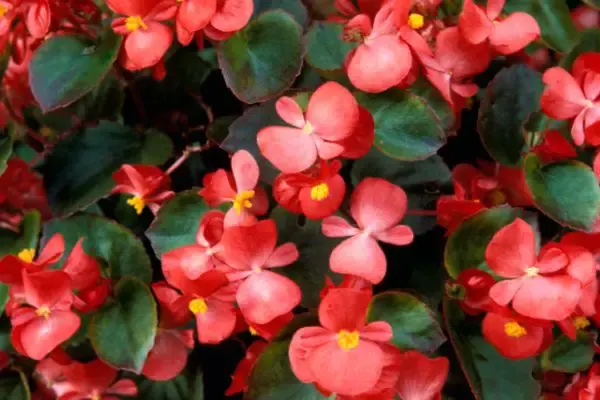
- Experience Level: Beginner
- Family: Begoniaceae
- Scientific Name: Begonia
- Other Names: Angel wings
- Adult Size: 6 to 18 inches (15 to 46 cm)
- Lifespan: Approximately 10 years
- Average Price Range: Seeds packets run around $5-6
Begonias are another colorful option that can thrive in full shade, while definitely bringing some high-definition color to your home garden. Depending on the variety, you’ve a wide range of sizes and colors to choose from – with orange, red, pink, white, and yellow being the most common varieties, though you can also find bicolors.
Once you’ve found a spot to plant them, then you can expect those blooms to make an appearance early in the summer and they’ll stick around until the first frost!
3. Bleeding heart
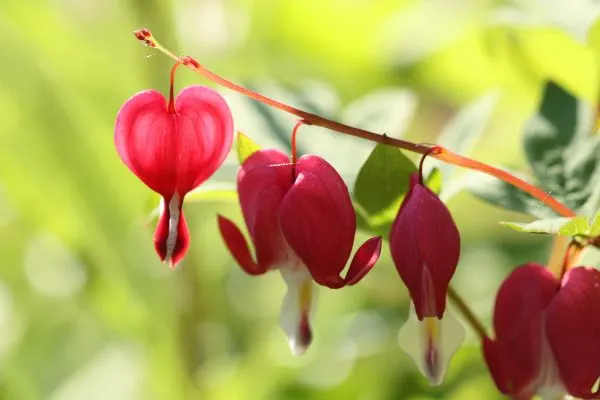
- Experience Level: Beginner
- Family: Papaveraceae
- Scientific Name: Dicentra
- Other Names: Dutchman’s breeches, Lady’s Locket, Lyre Flower
- Adult Size: 6 to 12 inches (15 to 30 cm)
- Lifespan: 3 to 4 years
- Average Price Range: Seeds priced around 5$ to $11, while bulbs and young plants may be around $25 to $50.
Said to be the ‘flowers of unrequited love’, Bleeding hearts are a garden option that you’ll definitely never get tired of – just don’t touch them. Bleeding hearts have amazingly beautiful flowers, with their purplish red hearts and white and crimson flowering below, but these plants are toxic to the touch.
It’s fair enough, we suppose, for ‘unrequited love’ flowers, but if you can keep yourself from handling them or simply tend them with gloves, the look that they’ll bring to the shady spots in your garden makes them well-worth your while!
4. Bletilla
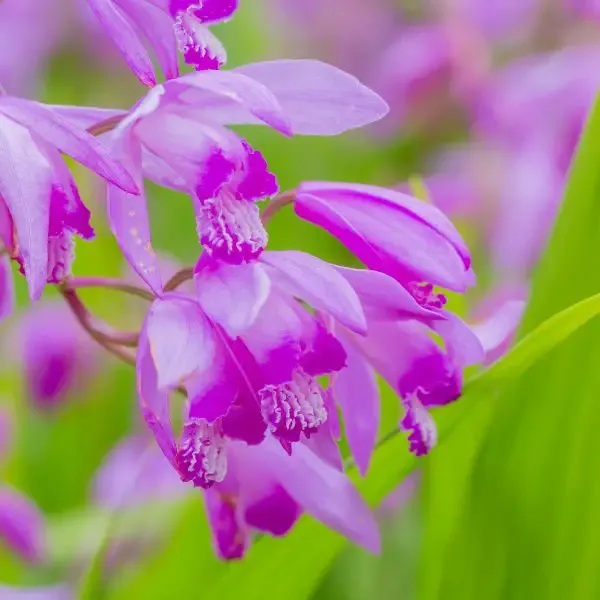
- Experience Level: Beginner
- Family: Orchidaceae
- Scientific Name: Bletilla
- Other Names: Urn Orchids
- Adult Size: 24 to 36 inches tall (60 to 90 cm) and 12 to 14 inches wide (30-60cm)
- Lifespan: 5 to 15 years, possibly longer
- Average Price Range: Seeds cost around $5, while bulbs may range from $8 to $36
While the Bletilla is also known as the ‘Chinese Ground Orchid’, it doesn’t have the same kind of maintenance level that you’ll find with other orchids – they are actually quite easy to raise, even for beginners.
Depending on the type that you choose, you can expect lovely yellow, white, pink, or even purple flowers that will make their debut in early to mid-summer, and those beauties should stick around for 4 to 6 weeks. If you want the look of orchids without high-maintenance requirements, then these are just about perfect.
5. Blue-eyed Grass
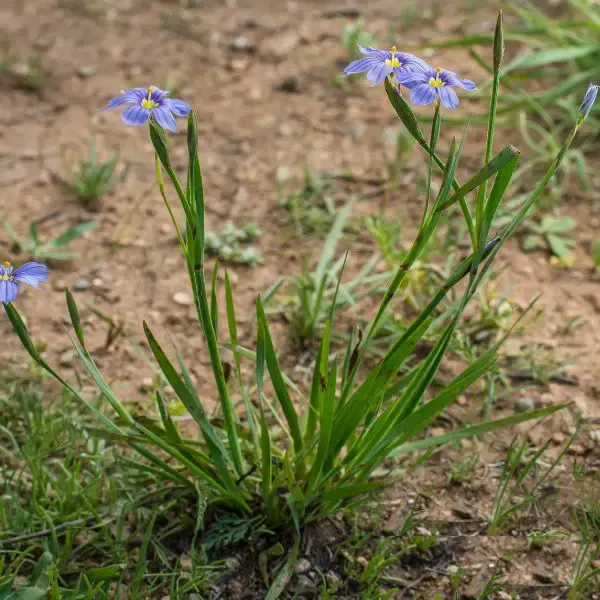
- Experience Level: Beginner
- Family: Iridaceae
- Scientific Name: Sisyrinchium
- Other Names: None
- Adult Size: 18 to 24 inches high (45 to 60 cm) and 6 to 12 inches wide (15 to 30 cm)
- Lifespan: Individual plants live only a few years, but established colonies are virtually perpetual
- Average Price Range: Seeds start around $3, while small plants range from around $7 to $12
While it sounds like you’re planting turf, don’t let the name fool you – Blue-eyed grass isn’t grass at all. The name comes from its thin stems, which resemble blades of grass, and when it flowers you can see lovely little blooms or purple, blue, white, or yellow (with the last two being much less common, but you can easily find them online!).
Once planted, they’ll start blooming between late spring and early summer and while individual plants don’t live for very long, once you’ve established a colony of these plants they’ll reseed themselves quite nicely so that you may enjoy them for many years.
We should mention, however, that technically this plant is a ‘cool season weed’ and so most either love this plant as a ‘Native American flower’, while others hate it – it’s really a judgment call.
That said, the flowers that they produce are quite lovely and it’s not an invasive species, spreading slowly via rhizomes wherever you’ve planted clumps of them.
6. Browallia
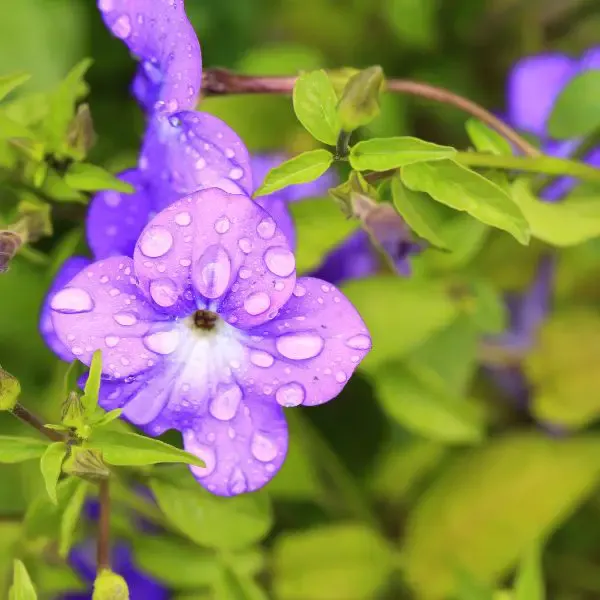
- Experience Level: Beginner
- Family: Nightshade (Solanaceae)
- Scientific Name: Browallia
- Other Names: Sapphire Flower, Bush Violet
- Adult Size: 8 to 24 inches (20 to 61 cm)
- Lifespan: Sometimes 1 season, though they reseed and some hardy plants may live for many years
- Average Price Range: Seeds run between $3.50 to 12$, while the plants themselves may range from $12 to $25 at your local nursery.
Browallia is an enchanting little nightshade that has become popular of late, populating window boxes and shaded nooks of many a garden you’ll find. It’s understandable – these mounding beauties bring colorful flowers of white, violet, or periwinkle blue in the early summer that stick around until the first frost.
To add to their charm, hummingbirds and butterflies seem to love them, so if you’d like to populate that shade with some nightshade, then you could do a whole lot worse than the beautiful Browallia.
7. Foamflower
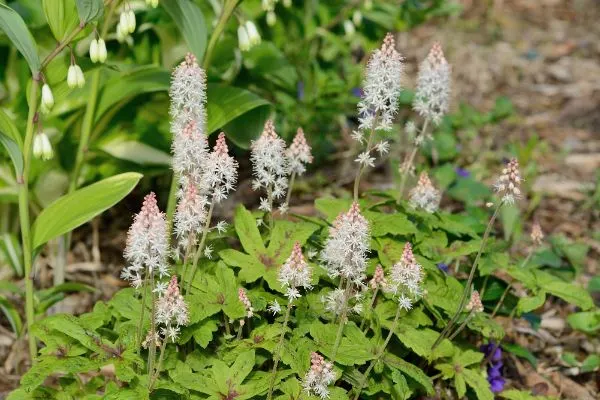
- Experience Level: Beginner
- Family: Saxifragaceae
- Scientific Name: Tiarella cordifolia
- Other Names: False Miterwort, Heart-leaved Foamflower
- Adult Size: 6 to 12 inches high (15 to 30 cm) and 12 to 36 inches (30 to 91 cm) wide
- Lifespan: Approximately 10 years
- Average Price Range: Seeds run between $3 to $15, while plants may be purchased for around $15.
Foamflowers bring the fluff with their lovely, 5-lobed florets. Also known as ‘tiarellas’, these plants do well in either full or partial shade, and come spring you’ll see lovely blooms of white, greenish-white, coral, or pink.
These plants also have heart-shaped leaves and are quite resistant to the cold, so if you are looking for fluffy, amazing flowers to fill in a little shaded spot in your garden, then consider the Foamflower – you’ll be happy that you did, come spring!
8. Foxglove
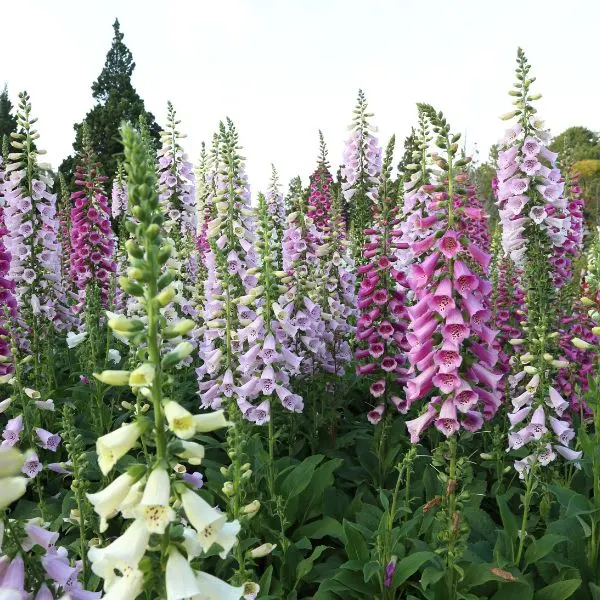
- Experience Level: Beginner
- Family: Scrophulariaceae
- Scientific Name: Digitalis purpurea
- Other Names: Goblin’s gloves, Witches gloves, Dead men’s bells
- Adult Size: 12 to 36 inches (30 to 91 cm) tall and wide
- Lifespan: 2 years
- Average Price Range: Seeds and plants cost $6 to $7, on average.
With tube-shaped flowers that come in yellow, pink, red, white, or purple, Foxglove is definitely quite the attractive option for filling a little shady space in your garden. These plants will do well in full or partial shade, and they also attract bees, butterflies, and hummingbirds who love the nectar of these beautiful plants.
Just don’t be tempted to take a nibble of any flowers yourself. While these plants are quite stunning when they bloom in early summer, they are also quite poisonous if you don’t happen to be a bee, hummingbird, butterfly, or a moth.
9. Fuchsia

- Experience Level: Beginner
- Family: Onagraceae
- Scientific Name: Fuchsia
- Other Names: The Chinese name translates to ‘the golden bell that hangs upside-down’
- Adult Size: 12 to 36 inches (30 to 91 cm) tall and 12 to 60 inches (30 to 152 cm) wide
- Lifespan: May live up to 30 years
- Average Price Range: Seeds cost between $7 and $15, on average, while live plants may run anywhere from $25 to $60, depending on the variety.
From early June until the first substantial frosting in autumn, the Fuchsia plant produces some blooms that will really turn a few heads. Despite the name being a singular color, the flowers and foliage can vary quite a bit depending on what you choose.
For instance, blooms may be orange, red, white, pink, or purple, while the leaves might be a mix of blue and green, silvers and grays, or chartreuse and gold! They’re definitely lookers and as long as they are at least getting a little indirect sunlight, then partial or even full shade should still get you lovely flowers and a healthy, beautiful foliage.
10. Impatiens
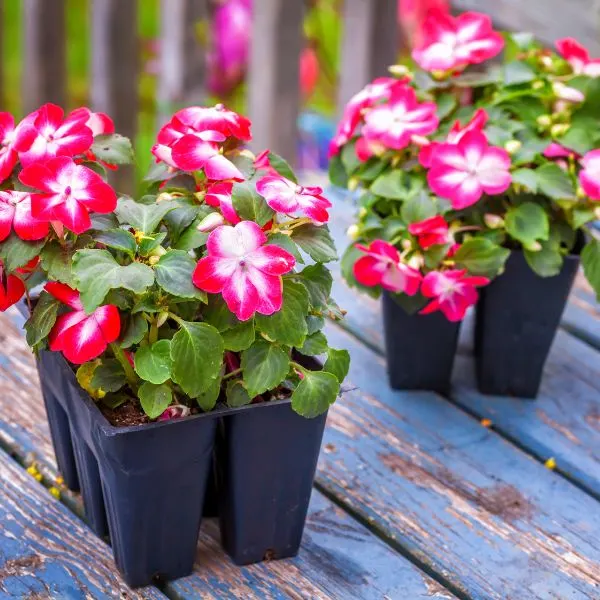
- Experience Level: Beginner
- Family: Balsaminaceae
- Scientific Name: Impatiens
- Other Names: Touch-me-not, jewelweed, patience
- Adult Size: 10 to 16 inches (25 to 40 cm) and 10 to 15 inches (25 to 38 cm) wide
- Lifespan: Varies – some species may live for many years
- Average Price Range: Seed prices vary, with an average range of $2 to $10, while live plants are usually $7 and up (depending on the species)
Despite how the name sounds, Impatiens will definitely not try your patience. This tropical species will do quite the opposite, actually, delighting you by blooming nonstop from spring all the way until the first decent frost arrives.
These lovely plants produce flowers of white, red, yellow, pink, orange, or blue, and if you don’t see a lot of flowers, you can pinch off the top 1/3 of an Impatiens plant and it will actually reward you with MORE blooms.
In partial or even full shade, they’ll deliver, so if you want a low-maintenance option that really brings the blooms then look no further – Impatiens is there to deliver!
11. Lungwort

- Experience Level: Beginner
- Family: Boraginaceae
- Scientific Name: Pulmonaria officialnalis
- Other Names: Jerusalem cowslip, Mary’s tears
- Adult Size: 6 to 12 inches (15 to 30 cm) high and 12 to 24 inches (30 to 60 cm ) wide
- Lifespan: Up to 10 years (in ideal conditions)
- Average Price Range: Seeds may run between $5 and $15, while potted plants average round $24/
While the name makes it sound like you shouldn’t breathe around this plant, Lungwort actually got its moniker from the color of its flowers – purple and blue – which reminded medieval herbalists of diseased lungs. In fact, it was even used as medicine, but as a shade-dwelling beauty this plant is put to a much better use.
The blooms of this plant will make their appearance in late March or early April, and you’ll get eye-catching flowers for a few weeks after that. As far as shade, these plants prefer light-to-medium shade, so just be sure to plant them with this in mind if you decide to grow a little Lungwort in your garden.
12. Wishbone Flower

- Experience Level: Beginner
- Family: Linderniaceae
- Scientific Name: Torenia fournieri
- Other Names: Blue Wings, Ola’a Beauty
- Adult Size: 6 to 16 inches (15 to 40 cm)
- Lifespan: Torenias are annuals but self-seeding may bring new plants in spring.
- Average Price Range: Seeds cost $6-$7, while live plants may be $15-$25
Our final entry in the world of shade-friendly plants is the Wishbone flower, which likes a little sun in the morning and a shady space in the afternoon. These flowering plants come with blue/green foliage and depending on what you choose, may bloom in white, pink, purple, yellow, or their most common color – blue.
The flowers that you get look like graceful little trumpets and if you’ve got hummingbirds in your area, then just wait until they see your Wishbone flowers – they absolutely LOVE them.
Even if you don’t have these birds locally, they’ll attract other useful pollinators and look pretty amazing doing it, with blooms appearing in the early summer and lasting until the first frost arrives.
FAQ
That’s just about all of the time that we have for today, but before we go we’ve got a few frequently asked questions that we think you might find useful. Let’s take a look and then we’ll get to wrapping things up for the day!
Can flowers really do well in the shade?
Believe it or not, quite a few perennials and annuals do quite well in the shade – Nature always finds a way, as they say. While most flowering plants will still need a little sun, depending on the type you can get away with a minimum amount of direct sunlight and still get some pretty amazing floral displays.
Just be sure to double check your choices to see if they thrive in partial or full sunlight, so that you know that they’re getting what they need, and prepare to be amazed. There are many, many flowers out there that will produce color in the shadiest spots in your garden!
What are some other flowers that don’t need a lot of sunlight?
There are way too many to mention, really, but we can certainly share a few more. Hydrangeas are a good example of shade loving flowers, and you can also go with Coral Bells, Lily-of-the-valley, Siberian bugloss, Rhododendrons… Well, let’s just say that you’ve definitely got options a-plenty!
Can roses grow in shade?
All roses will need a little sunlight, but some varieties may certainly thrive in partial shade. Some examples include the Fair Bianca, a lovely white rose, and you’ll find others like the ‘Red Knockout Rose’ and ‘Marmalade skies’.
Some final word on these Shade-lovin’ flowers
We hope that you’ve enjoyed our little article on 12 shade-loving flowers for your garden’s nooks and crannies. As you can see, there are plenty of options, both native and exotic, that will not only survive in the shade, but which will really bring some colorful and amazing blooms wherever you’ve planted them.
Just be sure to check if your favorites require partial shade or if they’re suited for full and after that, it’s just a matter of making sure they’re compatible for their neighbors. Before you know it, those shady spots in your garden will be all the more bright and beautiful for it!
If you are so inclined, then before you go please be sure to share one of your own tips in the comments. There’s never enough space to cover all of the plants that we’d like to share and we’d love to hear what your own favorite shade-loving flowers might be.
Until next time, thanks so much for visiting and we hope to see you again soon!
More gardening stuff
